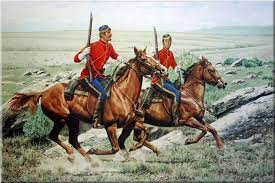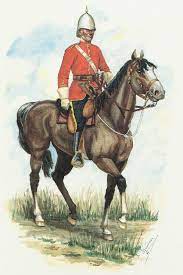From column #419 1920 THE TIMES TRAVELLER
THE BRILLIANT HISTORY of the ROYAL NORTH-WEST MOUNTED POLICE
The decision of the Canadian Government to increase the Royal North-West Mounted Police Force to more than five times the number ever engaged as patrollers of the far places calls attention to this remarkable body of men and their work as explorers. Indeed, little has been said of the daring feats of these men in mapping out huge tracts of unknown territory. During the decade or so that preceded the war they discovered great lakes, large mountain ranges, mighty rivers, vast herds of game, and new tribes of Indians and Eskimos whose existence was absolutely unknown. Here it might seem strange to speak of any parts of Canada as unknown or unexplored. Yet it is an indisputable fact that there are still big areas in the Northlands of the Dominion that are unknown country, and it is the officers of this remarkable police force who have done more than anybody else in filling in the blank spaces. In this work they have endured hardships and trials as great as those experienced by the most daring of African or Arctic adventurers.
The recent Order in Council made provision for increasing the force to 5,000, but at the moment the number aimed at is 2,500 men. Recruiting has been going on since May and has had a brisk response. The raising of the force is due to several reasons- the industrial unrest, the enormous new area which the force is to cover, and, not least, the decision to continue the exploration work which was dropped when war broke out and of which virtually nothing is known.
Until the Order in Council was passed the mounted police only had jurisdiction over the prairie provinces of Saskatchewan and Alberta, and the semi-arctic and arctic territories of Mackenzieland, Hudson Bay, and the Yukon. Now they have had their jurisdiction extended to the whole of British Columbia, Manitoba, and Into New Ontario as far as the shores of the Great Lakes- a stretch of territory almost as large as Europe without Russia.
When war broke out a unit of the Mounted Police went overseas and fought as a cavalry detachment. Large numbers also enlisted in various infantry regiments. So great was the depletion caused by war’s demands that the force, the top strength of which was 750 men in January, 1917, went down to 400 before the close of the campaign. Of this number 150 went to Siberia and served for some time with headquarters at Vladivostock. With their knowledge of arctic regions, the handling of dogs, wearing of snowshoes, etc., they proved a valuable corps.
The force was founded in 1873. At that time the new West was just being opened up. The monopoly of the Hudson’s Bay Company ceased in 1869, and their territory was taken over by the Dominion Government by purchase. Following the passing of the territory from the rigid sway of the fur company, a horde of whiskey smugglers and cattle runners swept in from the United States. To combat these men and retain law and order over a wilderness half a million square miles in extent, Sir John A. Macdonald took the matter up in Parliament, recommending that a force be organized “without gold lace.” This famous epigram stuck to the police for many years.

In May, 1873, the Bill was passed authorizing the Mounted Police. Three hundred men formed the first force. Recruited at Toronto, under Lieut.-Col. French, they travelled by train to the then end of the railway at Fargo, North Dakota. From here they marched eight hundred miles through the prairie country and established the first post at Fort McLeod, near the foothills of the Rocky Mountains. Later Fort Edmonton (Pile-of-bones), now Regina, the headquarters, and Calgary posts were established, all in what is now Alberta.
Another large post was established at Battleford, in what is now Saskatchewan. The most northern post to-day is that at Herschel, right away upon the extreme north-western tip of Canada in the Arctic Ocean. Here, too, is the “Farthest North” white man’s cemetery of any land, and from the cabin windows one may look across a stretch of lifeless barren land to the twenty-one crude wooden crosses that mark the graves of the twenty-one white men who have been buried here.
To Be Continued (TBC)
